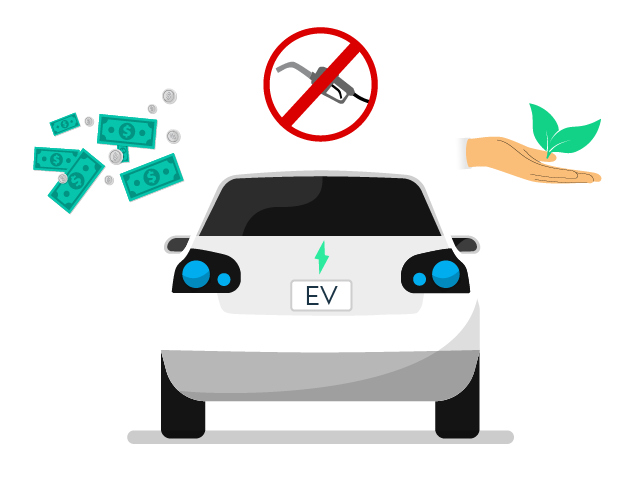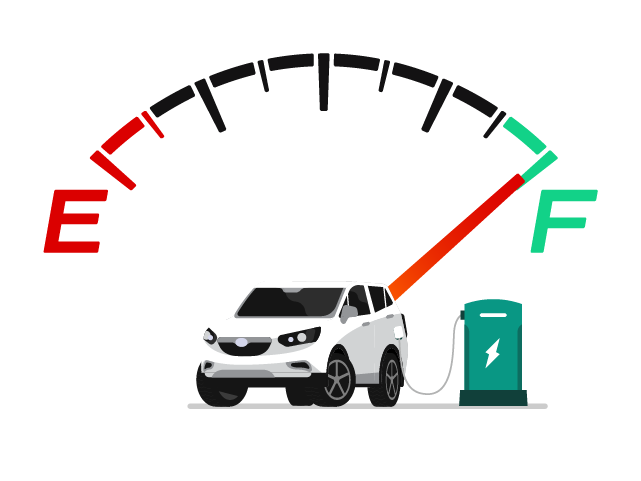Explore our comprehensive Electric Vehicle Buyer’s Guide that will help you make an informed decision when buying an electric car. Learn essential information to streamline your electric car buying journey.
Today, electric vehicles are more popular than ever. It’s becoming more and more common to see battery electric vehicles (BEVs) on the road and plugged into charging stations. Technology is improving rapidly, and automakers are hard at work building new electric vehicles of all shapes and sizes.
But are you ready to leave the world of gasoline behind for a new electrified adventure? If you’re thinking about buying or leasing electric cars, here’s what you should know first.
Table of Contents
- Intro
- What is an Electric Vehicle (EV)?
- Different Types of EVs
- Why Buy an EV?
- How Electric Vehicles Work
- Pros & Cons of Electric Vehicles
- Charging an EV at Home
- How Much Does an Electric Car Charger Cost?
- Public Charging Stations
- How Much Does Charging an EV Cost?
- How Long to Charge an EV?
- Is an Electric Vehicle Right for Me?
- Incentives & Tax Credits
- Do EV Batteries Have Enough Range?
- What Does EV Maintenance Look Like?
- Buying vs. Leasing an EV
- Used vs. New Electric Cars
- How Reliable Are EVs?
- Does Weather Affect EVs?
- Should I Have a Backup Gas-Powered Car?
- EVs & Auto Insurance
- Should I Buy an Extended Warranty on an Electric Car?
- EV Apps & Technology
- Want to Know More about Electric Vehicles?
What is an Electric Vehicle (EV)?
An electric vehicle (sometimes referred to as “battery electric vehicle”) is a vehicle that is powered by a motor that draws electricity from a battery that is capable of being charged from an external source. Electric vehicles come in all shapes and sizes, ranging from small hatchbacks suitable for the city, to giant electric trucks and SUVs that are ready for offroad adventures.
Different Types of EVs
In addition to the fully-electric battery electric vehicle, there are a few other types of electric vehicles.
Hybrid Electric Vehicles (HEVs) have a traditional gas engine along with a battery and electric motors. The engine and motors work together to power the vehicle. You do not have to plug HEVs in; instead, you just fill it up with gas like an internal combustion engine (ICE) car and the battery is charged through regenerative braking. Vehicles like the Toyota Prius and Honda Insight are examples of hybrid vehicles.
Plug-in Hybrid Electric Vehicles (PHEVs) also combine a gas engine with a battery and electric motors, and it functions much the same way as a hybrid. The main difference is these vehicles can be plugged in to charge the battery. PHEVs also have larger batteries than a standard hybrid, which allows them to have a longer electric driving range. Vehicles like the Toyota Prius Prime and Hyundai Tucson Plug-In Hybrid are examples of PHEVs.
Fuel Cell Electric Vehicles (FCEVs) use a hydrogen fuel cell to generate electricity to power its electric motor. You pump these cars full of pressurized hydrogen similar to how you’d pump gasoline. The chemical reaction between hydrogen and oxygen then powers the battery and electric motor, with the only emissions being heat and potable water. Vehicles like the Toyota Mirai and Hyundai Nexo are examples of FCEVs, and have very limited availability.
Read more: Hybrids vs. Plug-in Hybrids vs. Electric Vehicles
Read more: Hydrogen Fuel Cell Vehicles: The Future or a Fad?
Why Buy an EV?

The most obvious benefit of owning an electric car is not having to visit the gas station—unless you need coffee or snacks, of course. Consumer Reports found that charging at home can save EV owners up to $1,000 a year, a compelling reason to leave gasoline behind. Given that they have electric motors instead of gas-powered internal combustion engines, they are also less expensive to maintain on average.
EVs can also help the environment, as electric cars have zero tailpipe emissions and get you around more efficiently. Companies across all industries are working hard to lower their carbon footprint, and electric vehicles are key to reducing emissions in transportation. And while it’s true that emissions are produced by the manufacturing process for any vehicle, you can reduce the carbon debt by shopping for used electric vehicles.
Read More: How Electric Vehicles Save You Money
How Electric Vehicles Work
Most drivers are used to driving cars with a gas-powered engine and filling up at a gas station. Electric vehicles are different by design; they are powered by an electric motor and battery pack. To recharge, you simply plug it in at home or at a public charging station. If you recharge your vehicle daily and plan around your daily commute, owning an EV can be a lot like owning a smartphone.
While it’s widely known that electric vehicles are efficient, many people don’t realize that they can also be surprisingly fun to drive. Modern examples of EVs produce instant torque, enabling them to accelerate quickly from a standstill. Even entry-level EVs like the Nissan Leaf can accelerate from 0 to 60 miles per hour in as little as 6.5 seconds, which is comparable to some sports cars.
Pros & Cons of Electric Vehicles
Wondering about the pros and cons of electric vehicles? For most people, saving money on gasoline is a big enough reason to make the jump. Of course, you’ll need a place to plug in and charge if you want to make that happen. This may not be a problem if you’re a homeowner or have EV charging readily available to you, but you may need to spend extra time planning your next road trip.
Charging an EV at Home
Charging an electric vehicle at home is fairly straightforward. You can plug into a traditional AC outlet or install a Level 2 charger for faster results. How long it takes to charge an electric vehicle will vary depending on both your car and your charging equipment. If you’re able to plug in overnight, you should have enough charge to handle a short commute or run basic errands.
If it’s your first time buying an electric vehicle, you’ll probably want to have a charging solution at home. And while charging with a standard 110-volt outlet is possible, reaching a full charge using that method can take some time. A 240-volt outlet, currently the most popular option for homeowners, enables Level 2 charging. You can expect to recover 20 miles of range each hour, which is four times faster than the basic alternative.
Read more: Your Guide to Electric Vehicle Chargers
How Much Does an Electric Car Charger Cost?
Getting a charging station installed at home can add additional costs to your EV adventure, but it’s also a long-term investment that can pay off in big ways. You’ll need to purchase the equipment and have it professionally installed by an electrician, but you may be able to claim a federal tax credit to help offset the cost. And if you live in an apartment, it never hurts to let the building management know about your interest in EV charging to see if they’ll help with the cost of a charging station.
So, how much does an electric car charger cost? The national average price for charging stations is between $1,000 and $2,500. The cost varies based on your region and the type of station you buy.
Public Charging Stations

If you need to recharge when you’re away from home, you can use public charging stations and pay as you go. And as EVs increase in popularity, more charging stations are being built across the country, making long distance travel easier. You can use an app like Plugshare to find nearby stations and plan your route. The app includes user reviews, costs and hours, all thanks to the EV community.
Modern electric vehicles support Level 1 and Level 2 charging through the standard J1772 connector. Most (if not all) new EVs sold today support DC fast charging, which uses a special CHAdeMO connector. DC fast charging converts AC power into DC power prior to entering the vehicle, which charges vehicles with up to 80 miles of range for every 20 minutes of charging. To reduce wear, fast charging is limited to 80% of your battery capacity.
New car fast charging has come a long way in recent years. For example, the new Hyundai Ioniq 6 can fast charge from 10 to 80 percent in about 18 minutes, and the Audi e-Tron GT can go from 5 to 80 percent charged in 23 minutes.
Tesla vehicles can connect to standard J1772 outlets using an included adapter, but they also have access to Tesla Superchargers, which is a proprietary charging station that can recharge up to 75 miles in five minutes. This makes them especially viable for long distance driving.
Tesla has also set industry standards by allowing other EVs to use their Superchargers. Several automakers have signed agreements with Tesla to join the company’s charging network, with more to follow in the near future. At the moment, certain Supercharger stations across the country offer charging for non-Tesla vehicles. You can learn about the specifics here.
How Much Does Charging an EV Cost?
You may know that driving on electricity costs less than gasoline, but you may still be wondering about the exact cost to charge an electric vehicle. When it comes to home charging, what you pay will depend on where you live. The average price of electricity is 13.23 cents per kilowatt-hour. An EV like the Hyundai Ioniq Electric is estimated to use 25 kWh for every 100 miles, which would cost $3.30 to drive on average.
Read More: How Much Does It Cost to Charge an Electric Vehicle?
How Long to Charge an EV?
The equipment you use plays the most important role in determining how long you’ll need to keep the vehicle plugged in. Level 1 charging uses a standard AC outlet, charging up to 60 miles after 12 hours. A Level 2 charger requires special equipment, providing up to 250 miles after 12.5 hours. For an even faster experience, DC fast chargers can go from a 20 percent charge to 80 percent in an hour or less.
Read More: How Long Does it Take to Charge an Electric Vehicle?
Is an Electric Vehicle Right for Me?
You might be surprised at the variety of electric vehicles available today, with many more on the way. No longer are they just electric cars, either: Today, there are multiple electric SUVs and even electric pickup trucks on the market for sale, with plenty of others on the way soon.
The Ford Mustang Mach-E represents a bold new direction for Ford’s legendary nameplate. Meanwhile, the Hummer EV will deliver an astounding level of performance and utility while producing zero emissions. Electric vehicles will soon defy common stereotypes, and they’ll be doing it in a big way.
Automakers are looking to electrify more vehicles across their entire lineup, signaling a huge shift that’s already underway in the industry. The technology is also improving all the time, particularly in the areas of range and charging speeds. It’s an exciting time to own an electric vehicle, and it’s safe to say that you’ll be seeing more of them at the dealership.
Read More: What California’s Upcoming Gas Car Ban Means for You
Incentives & Tax Credits
Electric vehicle tax credits and rebates can help offset the sticker price of EVs at the dealership. There is a federal tax credit worth up to $7,500 for battery and fuel-cell EVs and plug-in hybrids that are assembled in North America and, after Jan. 1, 2023, that also meet strict rules regulating the origin of various battery materials. Various states also offer a variety of rebates and credits that can be worth up to $5,000. If you’re wondering what you might qualify for, it’s easy to check. For federal tax credit eligibility under terms of the Inflation Reduction Act of 2022 (IRA), check the Department of Energy’s regularly updated listing. For other federal and various state incentives for electric vehicles check the department’s alternative fuel center site under the “laws and incentives” tab. And don’t forget about your utility company, which may offer additional rebates.
Currently, the federal tax credit can be up to $7,500. Until 2023, the credit was limited to the first 200,000 qualified vehicles across their lineups, but that cap was lifted by the IRA. The tax benefit was recently modified by the Inflation Reduction Act through 2032, allowing for a maximum credit of $7,500 for new EVs and up to $4,000 (limited to 30% of the sale price) for used EVs.
The electric vehicle tax credit is a nonrefundable tax credit. This means it can lower your tax bill, but you won’t see any overages back in the form of a refund. To be absolutely sure of a vehicle’s provenance before committing to a purchase, enter its vehicle identification number, or VIN, on the tool provided on the federal VIN Decoder website – it will tell you in what country that specific car, SUV or truck was made
The IRA also established a tax credit of up to $4,000 for used EVS and PHEVS starting in 2023. That’s a first and it is intended to help lower-income individuals and families start driving electric. The used vehicles aren’t subject to the various country-or-original requirements that the IRA imposes on new electrified vehicles.
What about leases? Unfortunately, lessees of EVs can’t claim the federal tax credit, since the credit goes to the owner, and in a lease, the manufacturer owns the vehicle. The good news, however, is that dealers often pass on the savings in the form of a lower monthly payment. This can lead to some incredible deals on electric and plug-in vehicles, which can make them a compelling choice when compared to leasing a gas-powered car.
Read More: Everything You Need to Know About EV Tax Credits in 2023
Read More: How Electric Vehicles Save You Money
Do EV Batteries Have Enough Range?

When electric vehicles were first introduced, range anxiety was a real concern for owners. Charging stations were fewer and farther between, making longer trips less feasible. But today, electric vehicles are compelling options for all kinds of lifestyles. Many of the latest EVs offer a driving range of at least 250 miles, and the lifespan of EV batteries looks promising as well. But, there are plenty of EVs that offer even longer ranges.
The average round trip commute in the United States is just over 52 minutes, although that varies by state. As long as you can plug in when you get home, you should be able to recover that range overnight. To maximize your battery, avoid driving aggressively and be mindful of extreme weather. And while your vehicle will let you know how many miles you have left, it’s always a good idea to leave a buffer in case of an unexpected detour.
Read More: EV Driving Range: How Much Do You Really Need?
What Does EV Maintenance Look Like?
Gas-powered cars require regular maintenance intervals that include changing the engine oil, differential fluid and transmission fluid. Because an electric vehicle has fewer moving parts, you won’t have to worry about the complexities of a traditional powertrain. You’ll still need to keep up with your tires, brake pads and wiper fluid, but these items are typically much simpler to maintain.
Buying vs. Leasing an EV
There’s a lot to consider when you’re choosing whether to buy or lease an electric vehicle. Batteries are getting more efficient, and their range is increasing greatly over a typical 3-year lease which allows you to move up to greater range and newer technology every few years while only spending a third or a half of the typical purchase price for a new EV. Leasing an EV will ensure that you have the latest and greatest. For buyers, you’ll want to make sure that the range is sustainable for your long-term needs. Either way, you can expect a confidence-inspiring warranty of at least 8 years or 100,000 miles.
Read More: Why You Should Consider Leasing a Vehicle
Used vs. New Electric Cars
There are plenty of new electric vehicles to choose from, with several all-new models to get excited about. But if you’re looking for a bargain, a used EV can be an outstanding value. Many of the best used electric vehicles have depreciated quickly in a short amount of time and are available for a fraction of their original MSRP. You’ll also be giving a car a second life, which helps reduce your overall carbon footprint.
Read More: 5 Reasons to Consider Buying a Used EV
How Reliable Are EVs?
Owner satisfaction is high across the board for electric vehicles, but reliability can vary, especially between entry-level and premium electric vehicles. It’s hard to pinpoint an exact reason, but a simpler design usually means fewer things that can go wrong. Add more technology into the mix, and you’ve got more variables to account for. But for most people, an EV will be no less reliable than a traditional gas-powered vehicle.
Does Weather Affect EVs?

Extreme temperatures can impact any vehicle’s power and fuel efficiency, specifically the engine and tires. EV batteries are also affected by the weather, with both heat and cold leading to increased wear. Running the air conditioner will also reduce your mileage. To maximize your electric vehicle’s battery life, it’s a good idea to park in a covered space whenever possible.
Should I Have a Backup Gas-Powered Car?
Today, electric vehicles are a perfectly viable option for many lifestyles. Charging stations are more plentiful, and batteries last longer. But if you tend to do a lot of long-distance driving, it may make sense to have a backup vehicle when you need it. A hybrid or plug-in hybrid may fit the bill nicely, especially if you value efficiency and sustainability. If you don’t do much driving, you can simply borrow or rent a car when you need to head out of town.
EVs & Auto Insurance
Wondering how much it costs to insure an electric vehicle? You can generally expect higher costs compared to a gas-powered car, due to higher value and increased repair costs. This is a greater risk for your insurance company, which leads to a green premium for early adopters. Don’t worry, though. The money you save on fuel and maintenance can help offset these costs.
While it may be true that the more expensive EVs may have higher insurance costs, this isn’t the case with lower and moderately priced EVs. In fact, it’s not uncommon for EV drivers with excellent driving records to gravitate towards the more affordable models, where they can enjoy lower insurance premiums (in addition to the usual perks of electric vehicles).
Read More: Protecting Your Electric Car
Should I Buy an Extended Warranty on an Electric Car?
To shield yourself from potential unexpected costs, it may be worth considering a vehicle service contract when you buy or own an EV. A vehicle service contract is an agreement that covers the expenses of certain repairs for a specific period. These contracts are typically available from a dealer or third-party provider and can be purchased for both new and used vehicles.
By investing in a vehicle service contract, owners can enjoy peace of mind, knowing that they won’t have to bear the burden of repair costs out of pocket. While these contracts do come at an additional expense, they can save owners a significant amount of money over the life of the vehicle. Many vehicle service contracts cover items such as battery replacements and motor repairs which can be costly if paid for out of pocket.
Read More: Exploring Electric Vehicle Protection Products
EV Apps & Technology
There’s an app for everything these days, and cars are no different. If you buy an electric or plug-in vehicle, the automaker will most likely have a companion app you can use to track your vehicle’s location. Most importantly, you’ll know about its charging status and can adjust the temperature before you enter the vehicle. That’s just the tip of the iceberg for some vehicles. You can look forward to even more connectivity in the future.
Want to Know More about Electric Vehicles?
We’re keeping tabs on the best electric vehicles you can buy today, whether they’re new or used. You can also stay up to date on the latest EV news on the TrueCar Blog or on our Electric Vehicles Hub. And when you’re ready to buy an electric vehicle, you can use TrueCar to shop and get an up-front, personalized offer from a Certified Dealer.




